|
|
|
Sort Order |
|
|
|
Items / Page
|
|
|
|
|
|
|
| Srl | Item |
| 1 |
ID:
171074
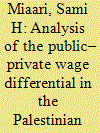

|
|
|
|
|
| Summary/Abstract |
This paper measures and analyzes the dynamics of the public–private wage differential in the West Bank and Gaza for the period before and during the ‘second Intifada’ using data from the Palestinian Labour Force Survey (PLFS) of the Palestinian Central Bureau of Statistics (PCBS). Because the distribution of workers’ individual characteristics, such as skills, and the ‘returns’ to these characteristics may differ across workers, the wage differential is decomposed into two components: an ‘endowment’ effect and a ‘returns’ effect. The results show that in the pre-Intifada period, the wage gap between the public and private sectors narrowed in both the West Bank and Gaza. However, a sharp increase is seen after the outbreak of the Intifada. Moreover, most of this increase comes from an increase in ‘returns’ to skills composition in the public sector, (unexplained effect), rather than a change in the skills composition of public sector workers, (explained effect). Using recent econometric quantile regression techniques, the analysis of the public–private sector wage gap from 1998 to 2006, at various points along the wage distribution, shows that the wage premium, (penalty), for the public sector varies across the distribution, being higher, (lower), at the lowest end of the wage distribution and decreasing (increasing) along the wage distribution; it becomes negative in the top percentiles.
|
|
|
|
|
|
|
|
|
|
|
|
|
|
|
|
| 2 |
ID:
107489
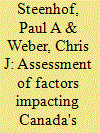

|
|
|
|
|
| Publication |
2011.
|
| Summary/Abstract |
In this article we develop and then implement a decomposition model of Canada's electricity sector in order to assess multiple factors impacting on trends in greenhouse gas emissions from the sector, with a focus on the impact of climate and energy policy on emissions for the time period spanning from 1990 to 2008. The analysis shows that during these years, the primary factors driving changes in emissions included changes in electricity demand, changes in the generation mix of electricity, and weather, but that government policy and programs had only minor impacts on emissions. Although having relatively lesser impacts compared to the aforementioned factors, the most significant policy related factors included efforts to increase renewables in the generation mix through programs such as renewable portfolio standards and incentives for wind generators.
|
|
|
|
|
|
|
|
|
|
|
|
|
|
|
|
| 3 |
ID:
116740


|
|
|
|
|
| Publication |
2012.
|
| Summary/Abstract |
This study analyzes China's industrial energy consumption trends from 1996 to 2010 with a focus on the impact of the Top-1000 Enterprises Energy-Saving Program and the Ten Key Energy-Saving Projects. From 1996 to 2010, China's industrial energy consumption increased by 134%, even as the industrial economic energy intensity decreased by 46%. Decomposition analysis shows that the production effect was the dominant cause of the rapid growth in industrial energy consumption, while the efficiency effect was the major factor slowing the growth of industrial energy consumption. The structural effect had a relatively small and fluctuating influence. Analysis shows the strong association of industrial energy consumption with the growth of China's economy and changing energy policies. An assessment of the Top-1000 Enterprises Energy-Saving Program and the Ten Key Energy-Saving Projects indicates that the economic energy intensity of major energy-intensive industrial sub-sectors, as well as the physical energy intensity of major energy-intensive industrial products, decreased significantly during China's 11th Five Year Plan (FYP) period (2006-2010). This study also shows the importance and challenge of realizing structural change toward less energy-intensive activities in China during the 12th FYP period (2011-2015).
|
|
|
|
|
|
|
|
|
|
|
|
|
|
|
|
| 4 |
ID:
078029


|
|
|
|
|
| Publication |
2007.
|
| Summary/Abstract |
A concentration index methodology to analyze the inequality in childhood malnutrition in China is outlined. Height-for-age z-score is used as a measure of childhood malnutrition. Using household survey data from nine Chinese provinces, we found that per capita household income, household head's education, urban residence and access to a bus stop are associated with lower malnutrition. Child's age has a nonlinear relationship with the malnutrition status. Income growth and access to public transportation are associated with less severe inequality, while rural-urban gap, provincial differentials, and unequal distribution of household head's education are associated with higher levels of inequality in childhood malnutrition. Gender is not relevant for either malnutrition status or inequality. Investments in infrastructure and welfare programs are recommended to ameliorate the inequality in childhood malnutrition
|
|
|
|
|
|
|
|
|
|
|
|
|
|
|
|
| 5 |
ID:
106231


|
|
|
|
|
| Publication |
2011.
|
| Summary/Abstract |
This study examines changes in Chinese urban income distribution from 1987 to 1996 and 1996 to 2004 using nationwide household data and investigates the causes of these changes. The Firpo, Fortin, and Lemieux (2007, 2009) method based on unconditional quantile regressions is used to decompose changes in income distribution and income inequality measures, such as variance and a 10:90 ratio. The decomposition results show that wage structure effects, such as a widening gender earnings gap, increases in returns to college education, and increases in earnings differentials between industries, company ownership types, and regions, have been the major contributors to the overall increases in income inequality. It was also found that at different points on the income distribution (e.g., the lower or upper half), the contributing factors that increase income inequality are different.
|
|
|
|
|
|
|
|
|
|
|
|
|
|
|
|
| 6 |
ID:
094661


|
|
|
|
|
| Publication |
2010.
|
| Summary/Abstract |
This article uses multivariate regression and decomposition analyses to assess household income mobility determinants and their contributions to income mobility in rural China from 1989 to 2006. The findings indicate that households with lower initial income level, higher share of wage income, higher educational level of household members, larger number of non-agricultural employed household members and younger heads are more mobile. Moreover, besides initial income, change in the share of wage income, change in the share of non-agricultural employed household members, and change in average year of education of household members are the most important factors that account for income mobility. These findings necessitate more emphasis on policies that promote non-agricultural employment and education to enhance household income mobility in rural China.
|
|
|
|
|
|
|
|
|
|
|
|
|
|
|
|
| 7 |
ID:
124982
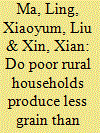

|
|
|
|
|
| Publication |
2013.
|
| Summary/Abstract |
China's poor rural households produce substantially less grain compared with non-poor rural households. The present paper applies a decomposition approach and uses China's rural household survey data to investigate the causes of this grain output gap. The paper first compares the grain output gap between poor and non-poor rural households, and then decomposes the gap into differences in yield and area sown. The results indicate that the gap in grain output mainly results from differences in the amount of inputs used in production. Differences in the number of labor days and the level of intermediate inputs account for 13.6 and 47.5 percent of the gap, respectively. Poor rural households are also less efficient in their use of intermediate inputs, which contributes to 13.2 percent of the gap. However, the efficiency of poor households' labor days reduces the gap by 7.2 percent, while agricultural physical capital, household head education and agricultural training have no substantial impact on the household grain output gap.
|
|
|
|
|
|
|
|
|
|
|
|
|
|
|
|
| 8 |
ID:
117262
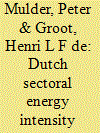

|
|
|
|
|
| Publication |
2013.
|
| Summary/Abstract |
This paper makes use of a new dataset to investigate energy intensity developments in the Netherlands over the period 1987-2005. The dataset allows for a comparison with 18 other OECD countries. A key feature of our analysis is that we combine a cross-country perspective with a high level of sectoral detail, covering 49 sectors. Particularly innovative is our evaluation of energy intensity developments in a wide range of Service sectors. We find that across sectors, energy intensity levels in the Netherlands on average decreased only marginally, and increased in Services. This performance is in general worse than the OECD average, especially between 1987 and 1995. Changes in the sectoral composition of the economy play an important role in explaining aggregate trends. In the Manufacturing sector, about half of the efficiency improvements were undone by a shift towards a more energy-intensive industry structure. In contrast, in the Service sector efficiency decreased, which was undone for about one third by a shift towards a less energy-intensive sector structure.
|
|
|
|
|
|
|
|
|
|
|
|
|
|
|
|
| 9 |
ID:
182742


|
|
|
|
|
| Summary/Abstract |
Researchers have long puzzled over China's high household savings rate. Some have hypothesized that the explanation lies with China's One-Child Policy (OCP). According to this hypothesis, faced with fewer children to support them in their old age, Chinese parents increased their savings to finance retirement. Previous research relied on empirical studies of the relationship between children and saving behavior. However, all of these studies based their analysis on data after the OCP was implemented. Their implicit counterfactual for China without an OCP was households with multiple children living in an OCP environment. In contrast, we compare Chinese people with people from regions that do not have restrictive population policies. These regions share many cultural, demographic and economic characteristics with China that suggest they can be used as a counterfactual for China. This approach enables us to employ a Blinder-Oaxaca decomposition procedure to identify the different channels by which children could affect savings. Our results suggest that the OCP decreased households' proclivity to save. The estimated effects are generally small, in the range of one to two percentage points. We find no evidence to indicate that the OCP can explain China's high saving rate. An implication of our findings is that they suggest that the recent relaxation of the OCP cannot be counted upon to substantially boost Chinese consumption.
|
|
|
|
|
|
|
|
|
|
|
|
|
|
|
|
| 10 |
ID:
156461


|
|
|
|
|
| Summary/Abstract |
This paper aims to measure and understand the rural–urban student cognitive ability gap in China. Using the China Education Panel Survey (CEPS) 2013/2014 data, we find that the cognitive ability test scores of urban students are approximately 1.41 points (17%) higher than those of rural students, on average. This difference is equivalent to 37 and 41% of the standard deviation of urban and rural students' test scores, respectively. Instead of the raw test score, when the cognitive ability is estimated with the 3-parameter Logistic item response theory model, the rural–urban gap is somewhat reduced. The regression and Oaxaca–Blinder decomposition analyses show that nearly one-half of the rural–urban gap can be accounted for by differences in observed characteristics, especially number of siblings, parental education, and interaction between parents and teachers. We then discuss the policy implications of these results and propose a few potential ways to reduce the rural–urban gap in students' cognitive abilities.
|
|
|
|
|
|
|
|
|
|
|
|
|
|
|
|
| 11 |
ID:
187134


|
|
|
|
|
| Summary/Abstract |
In Bangladesh, despite increased participation in the labour market in recent decades, women are still lagging behind men by a significant margin, with the former being concentrated chiefly in low-paid agriculture as well as in the lower stages of the occupational ladder. With the help of the latest labour market data of 2016–2017 coupled with 2011 census data, this article attempts to examine gender segregation through sectoral and occupational lenses. Our econometric estimation of different sectors (agriculture, manufacturing, construction and service) reflects the importance of gender-centric factors such as care burden and marital status along with local employment opportunities in constraining women’s labour market engagement. Besides, decomposition analysis highlights that unfavourable returns to endowments play a crucial role in females’ concentration in relatively low-productive sectors. Sectoral and occupational segregation indices reflect a high degree of segregation between men and women. Thus, against the backdrop of the concentration of women in low-skilled jobs and a low-productive sector, this article expects to provide important policy insights for boosting female employment in relatively high-productive sectors and high-paid occupations while utilizing the structural shift in the labour market of Bangladesh.
|
|
|
|
|
|
|
|
|
|
|
|
|
|
|
|
| 12 |
ID:
142032


|
|
|
|
|
| Summary/Abstract |
Whether intergovernmental transfers can remedy geographic disparities in development without an explicit horizontal equalization feature has been a matter of dispute. To address the issue, I explore spatial inequalities in per capita local government income in the Philippines across alternative notions of geography and examine the intersecting effect of vertical revenue transfers on observed inequalities. The Gini and Theil indices and their corresponding subgroup decompositions are utilized as analytic tools. First, overall inequality in local government income generation is moderate across national space. Second, the severity of income inequality varies across different geographic groupings. Third, it is shown that the current Philippine transfer system has a substantial equalizing effect in terms of national inequality, but a negligible impact on specific spatial inequalities. Notably, spatial income inequalities between local governments have remained steady over the last decade. Additionally, local governments are not sharply stratified over national space. Rather, the space economy is composed of several overlapping regional economic systems. The implications for intergovernmental fiscal transfer policy reform is discussed.
|
|
|
|
|
|
|
|
|
|
|
|
|
|
|
|
| 13 |
ID:
149881
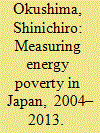

|
|
|
|
|
| Summary/Abstract |
This paper first examines energy (or fuel) poverty in Japan from 2004 to 2013, especially around the time of the 2011 Great East Japan Earthquake (GEJE). To analyze the issue, the paper employs various poverty and vulnerability measures with the assistance of our unique dataset. The results indicate the aggravation of energy poverty among lower-income and vulnerable households during the past decade, resulting from both the escalation of energy prices and lowering of income. The analysis also employs a new decomposition technique and identifies the explanatory factors associated with the increase in energy poverty. These results suggest there were major changes in the forces driving the increase in energy poverty before and after the GEJE. After 2011, income alleviates energy poverty in Japan, with energy prices becoming the main driving factor.
|
|
|
|
|
|
|
|
|
|
|
|
|
|
|
|
| 14 |
ID:
170346


|
|
|
|
|
| Summary/Abstract |
Using data from the China Health and Nutrition Survey, this study analyses changes in bodyweight (body mass index and waist circumference) distributions between 1991 and 2011 among adults aged 20+ in China. To do so, we quantify the source and extent of temporal changes in bodyweight and then decompose the increase in obesity prevalence into two components: a rightward shift of the bodyweight distribution (mean growth) and a (re)distributional skewing. Our analysis reveals a clear rightward distributional shift combined with a leftward skewing. Although the relatively large size of this skewing in the first decade analysed reflects an increase in obesity inequality, this inequality growth subsides in the second decade. Nevertheless, over the entire 20-year period, obesity inequality increases significantly, especially among females, younger age groups, residents in rural and western provinces, and individuals with low socioeconomic status.
|
|
|
|
|
|
|
|
|
|
|
|
|
|
|
|
| 15 |
ID:
115130


|
|
|
|
|
| Publication |
2012.
|
| Summary/Abstract |
Concerns over impacts from U.S. energy use on the environment, the economy and the national security warrant an understanding of the key drivers of energy consumption. This paper focuses on decomposing U.S. household energy consumption changes into several factors that have affected its growth. The interval analyzed is based on household surveys conducted by the U.S. Energy Information Administration from 1980 through 2005. Drivers of total household energy consumption, total household electricity consumption and natural gas use for space heating are analyzed and contrasted. While not definitive, sub-period analyses split at 1990, show greater reductions in energy intensity in the later sub-period and provide prima fascia evidence of the efficacy of U.S. efforts to promote energy efficiency through various standards and programs.
|
|
|
|
|
|
|
|
|
|
|
|
|
|
|
|
| 16 |
ID:
147418


|
|
|
|
|
| Summary/Abstract |
Job search procedures are a form of human capital investment in that they involve current investments to enhance future returns, analogous to human capital investments in areas such as education, training and mobility that yield future returns. While the theoretical and empirical literature on job search is extensive, most of it involves developed countries. There is less on developing countries and very little on China involving migrant workers in spite of their growing practical and policy importance and the fact that they are constantly engaging in job search. This paper examines the use and impact of job search procedures used by migrant workers in China by taking advantage of a rich data set on migrant workers that has information on their job search procedure as well as a wide array of other personal and human capital characteristics. Our OLS estimates indicate that there is no effect on earnings of using informal versus formal job search procedures for migrant workers in China. However, our IV results suggest that the OLS estimates are subject to severe selection bias from the fact that the choice of job search procedure is endogenous, associated with unobservable factors that affect the choice of informal versus formal procedures and that affect the earnings outcome. Our three different IV estimates designed to deal with this bias indicate that informal procedures (various aspects of family and friends) are associated with earnings that are 33 to 43% below the uses of more formal procedures. The decomposition results indicate that the most important variable contributing to pay advantage of those who use formal as opposed to informal procedures is education. In sum, our results suggest that policies to encourage or facilitate migrant workers using more formal job search procedures and reducing barriers that compel them to rely on informal procedures can yield better job matches with higher earnings.
|
|
|
|
|
|
|
|
|
|
|
|
|
|
|
|
| 17 |
ID:
182729
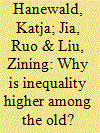

|
|
|
|
|
| Summary/Abstract |
This paper studies income inequality in old age and its development over the life cycle. We show that income is more unequally distributed in old age than in working age. We combine the regression-based inequality decomposition method and the three-step mediating effect test to analyze the transmission of income inequality from initial socioeconomic differences to income inequality in old age. Our study is based on a panel of over 4000 old households from the China Health and Nutrition Survey during 1991–2015. We find that the urban-rural gap and educational inequality are the primary causes of old-age income inequality. The effect of the urban-rural gap is partially mediated by educational inequality. Inequality accumulates with age and is reinforced in old age by the fragmented Chinese public pension system.
|
|
|
|
|
|
|
|
|
|
|
|
|
|
|
|
|
|
|
|
|